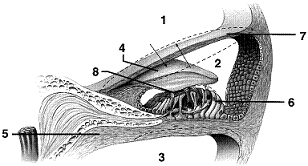When you increased the predation rate, did the prey isocline go up or down, i.e. did the number of predators required to maintain the prey population at zero growth increase or decrease?
a. It went down.
b. It went up.
c. It didn't change.
a
You might also like to view...
By organizing socially into a group, individual animals may benefit by
A) coexisting peacefully instead of fighting with group members for dominance. B) reducing intraspecific competition for food. C) increasing access to a common food supply. D) equalizing the number of offspring produced by each group member.
In Figure 43-3, the basilar membrane is labeled:

a. 4.
b. 5.
c. 6.
d. 7.
e. 8.
Which of the following is not a health risk associated with obesity?
A) type 2 diabetes B) atherosclerosis C) type 1 diabetes D) colon and rectal cancer
A photosensitive red spot that permits photosynthetic euglenoids to detect the presence of light is called a ______ .
A) pellicle B) stigma C) phycobilin D) diatom